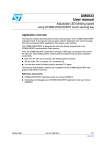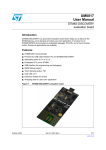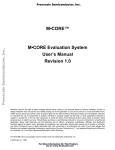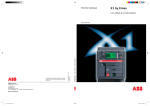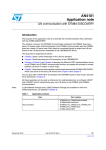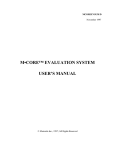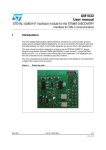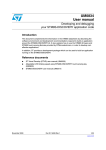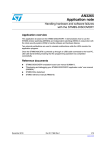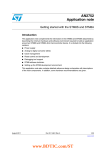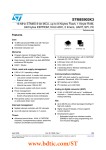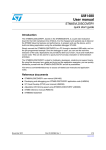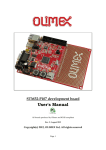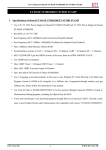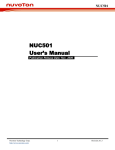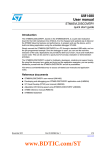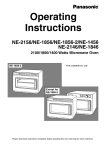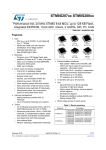Download Adjustable buzzer frequency using STM8S
Transcript
AN3277 Application Note Adjustable buzzer frequency using STM8S-DISCOVERY touch sensing key Application overview This application note provides a short description of how 3BEEP application software can use a Beeper peripheral to take advantage of the STM8S-DISCOVERY touch sensing key, TS1. Once the STM8S105C6T6 is powered-up through a USB cable connected to the host PC, the LED LD1 switches on, meaning that the programming has been completed successfully. ■ Each time the TS1 key is pressed, the Beeper emits a beep at different frequencies, 1 KHz, 2 KHz and 4 KHz respectively. ■ The fourth time TS1 is pressed, the Beeper stops emitting. ■ A Beeper cycle can then be restarted by pressing TS1 again. Alternate function remapping must be performed on the STM8S105C6T6 before the Beeper peripheral can be used in this manner. This is described in UM0834. Even though the STM8S-DISCOVERY is built around an STM8S105C6T6, it allows evaluation of the main features of all the STM8S MCUs. Reference documents October 2010 ■ STM8S-DISCOVERY evaluation board user manual (UM0817). ■ Developing and debugging STM8S-DISCOVERY application code user manual (UM0834). Doc ID 17979 Rev 1 1/13 www.st.com Contents AN3277 Contents 1 Application description . . . . . . . . . . . . . . . . . . . . . . . . . . . . . . . . . . . . . . 5 1.1 Hardware required . . . . . . . . . . . . . . . . . . . . . . . . . . . . . . . . . . . . . . . . . . . 5 1.2 Application schematics . . . . . . . . . . . . . . . . . . . . . . . . . . . . . . . . . . . . . . . . 5 1.3 Application principle . . . . . . . . . . . . . . . . . . . . . . . . . . . . . . . . . . . . . . . . . . 6 2 Option byte configuration . . . . . . . . . . . . . . . . . . . . . . . . . . . . . . . . . . . . 7 3 Software description . . . . . . . . . . . . . . . . . . . . . . . . . . . . . . . . . . . . . . . . . 8 4 2/13 3.1 Touch sensing library configuration . . . . . . . . . . . . . . . . . . . . . . . . . . . . . . 8 3.2 Standard STM8S firmware library configuration . . . . . . . . . . . . . . . . . . . . 9 3.3 Application software flowcharts . . . . . . . . . . . . . . . . . . . . . . . . . . . . . . . . 10 3.3.1 Main loop flowchart . . . . . . . . . . . . . . . . . . . . . . . . . . . . . . . . . . . . . . . . 10 3.3.2 ExtraCode_StateMachine flowchart . . . . . . . . . . . . . . . . . . . . . . . . . . . 11 Revision history . . . . . . . . . . . . . . . . . . . . . . . . . . . . . . . . . . . . . . . . . . . 12 Doc ID 17979 Rev 1 AN3277 List of tables List of tables Table 1. Table 2. Table 3. Beeper configuration. . . . . . . . . . . . . . . . . . . . . . . . . . . . . . . . . . . . . . . . . . . . . . . . . . . . . . . 6 Touch sensing library configuration . . . . . . . . . . . . . . . . . . . . . . . . . . . . . . . . . . . . . . . . . . . 8 Document revision history . . . . . . . . . . . . . . . . . . . . . . . . . . . . . . . . . . . . . . . . . . . . . . . . . 12 Doc ID 17979 Rev 1 3/13 List of figures AN3277 List of figures Figure 1. Figure 2. Figure 3. 4/13 Application schematics . . . . . . . . . . . . . . . . . . . . . . . . . . . . . . . . . . . . . . . . . . . . . . . . . . . . . 5 Main application loop flowchart. . . . . . . . . . . . . . . . . . . . . . . . . . . . . . . . . . . . . . . . . . . . . . 10 ExtraCode_StateMachine flowchart . . . . . . . . . . . . . . . . . . . . . . . . . . . . . . . . . . . . . . . . . . 11 Doc ID 17979 Rev 1 AN3277 Application description 1 Application description 1.1 Hardware required The following STM8S-DISCOVERY on-board resources are used: ● Touch sensing key, TS1 ● LED, LD1 A piezo buzzer with an operating voltage of 5 V and which supports a frequency range of 1 KHz to 4 KHz is required to make the 3BEEP application software run on the STM8SDISCOVERY. 1.2 Application schematics Figure 1 shows the touch sensing key implementation principle based on the RC acquisition method. For STM8S-DISCOVERY implementation details, refer to the board schematic provided in the STM8S-DISCOVERY user manual (UM0817). For detailed information about RC acquisition principle for touch sensing applications, refer to AN2927. Figure 1. Application schematics 6$$ ,$GREEN #4^P& 0# LOAD)/ 2Ω 2- Ω 2+ 0$ "UZZERPIEZO 34-3 0# ACQ)/ 0$ %ARTH Ω 4 3 #8 AI Doc ID 17979 Rev 1 5/13 Application description 1.3 AN3277 Application principle This application uses the Beeper peripheral to output a signal on the Beeper pin for sound generation. Each time the STM8S microcontroller detects a touch event on TS1, the Beeper output frequency is reprogrammed as described in Table 1. At the fourth touch, the Beeper is disabled. You can then restart the cycle. The LED LD1 is switched on at application start-up, this verifies visually that the STM8S Flash memory was successfully programmed. A Table 1. 6/13 Beeper configuration TS1 state Beeper frequency At start-up No sound 1st TS1 touch 1 KHz 2nd TS1 touch 2 KHz 3rd TS1 touch 4 KHz Doc ID 17979 Rev 1 AN3277 2 Option byte configuration Option byte configuration On the STM8S105C6T6, the Beeper output is an alternate function which is available only after remapping. As a result, the alternate function remapping bit 7 (AFR7) of the option byte OPT2 must be modified as follows: 0: Port D4 alternate function = TIM2_CH1 (default) 1: Port D4 alternate function = Beep (required) For alternate function remapping details, refer to UM0834. For option byte details, refer to the STM8S105xx datasheet. Doc ID 17979 Rev 1 7/13 Software description 3 AN3277 Software description The application software uses both STM8S standard and touch sensing firmware libraries to control general purpose functions and touch sensing peripherals. These functions and peripherals are: ● Clock (CLK) The clock control enables and delivers the correct clock frequency to the CPU and peripherals. It configures the HSI prescaler division factor from 8 to 1. ● GPIOs They drive the MCU I/Os to interface with external hardware. They configure ports PD0 and PD4 as output push-pull low (to drive the LED LD1 and switch it on at initialization) as well as the Beeper output pin. ● Beeper This peripheral drives the Beeper output pin with a signal in the range of 1, 2 or 4 KHz for sound generation. ● Timer 3 (TIM3) This is a 16-bit timer with an 8-bit prescaler. The touch sensing firmware library uses Timer 3 for touch sensing acquisition (TIMACQ). See Table 2 for the corresponding define statement in the STM8 touch sensing library. It also performs LSI calibration before the LSI is used as the clock source of the Beeper. ● Timer 4 (TIM4) This is a basic 8-bit timer used as a generic time base (TIMTICK). This time base is used by the touch sensing firmware library to control the charge/discharge cycles of the RC network (resistor R4 plus TS1 electrode). Timer 4 is also used by the application to control LD1 blinking speed. It is distinct from the acquisition Timer 3. See Table 2 for the corresponding define statement in the STM8 touch sensing library. 3.1 Touch sensing library configuration The STM8_TSL_RC_Configuration.h file configures the touch sensing library. Table 2 describes the main define statements required to configure the library for the STM8S-DISCOVERY to control the TS1 touch sensing key. The other define statements should keep their default values. Refer to the STM8 touch sensing library online help for details concerning these define statements. Table 2. Touch sensing library configuration Function #define statement MCU selection STM8S Acquisition timer TIMACQ TIMACQ_CNTR_ADD Time-base timer TIMTICK Load I/O LOADREF_PORT_ADDR LOADREF_BIT 8/13 Value 1 TIM3 0x5328 TIM4 Comment TIM3 base address - GPIOC_BaseAddress Port PC4 selected 0x04 Doc ID 17979 Rev 1 AN3277 Table 2. Software description Touch sensing library configuration (continued) Function #define statement Single channel key SCKEY_P1_KEY_COUNT SCKEY_P1_PORT_ADDR SCKEY_P1_A SCKEY_P1_DRIVEN_SHIELD_MASK SCKEY_P2_COUNT SCKEY_P3_COUNT Multichannel key NUMBER_OF_MULTI_CHANNEL_KEYS Electrode mask GPIOA_ELECTRODES_MASK GPIOB_ELECTRODES_MASK GPIOC_ELECTRODES_MASK GPIOD_ELECTRODES_MASK GPIOE_ELECTRODES_MASK GPIOF_ELECTRODES_MASK GPIOG_ELECTRODES_MASK GPIOH_ELECTRODES_MASK GPIOI_ELECTRODES_MASK 3.2 Value 1 GPIOC_BaseAddress 0x02 0x08 0 0 Comment Number of keys = 1 Port PC selected Pin 1 selected as acquisition input Pin 3 for active shield Key port P2 not used Key port P3 not used 0 Multichannel key feature disabled 0x00 0x00 0x0A 0x00 0x00 0x00 0x00 0x00 0x00 Defines the electrode mask for each GPIO used. Mask must be set to 0x00 for unused GPIOs. Standard STM8S firmware library configuration The stm8s_conf.h file of the STM8S standard firmware library configures the library by enabling the peripherals used by the application. The following define statements must be present: ● #define _CLK 1 enables the clock control CLK ● #define _GPIO 1 enables the GPIOs ● #define _BEEP 1 enables the Beeper ● #define _TIM3 1 enables the Timer 3 Doc ID 17979 Rev 1 9/13 Software description 3.3 AN3277 Application software flowcharts This section gives an overview of the application software main loop, and of the function that controls sound frequency generation. Detailed information can be found in the STM8S-DISCOVERY software user manual (UM0834). 3.3.1 Main loop flowchart Figure 2 shows the flowchart of the application software main loop. Functions TSL_init() and TSL_Action() in the API of the touch sensing library initialize the library and control the state machine that sequences the touch sensing management. Figure 2. Main application loop flowchart START Clock configuration Configures HSI prescaler division factor from 8 to 1 => Fmaster = 16 MHz GPIO configuration Configures PD0 and PD4 as output push-pull low to drive LED LD1 and buzzer Piezo, respectively. LD1 is swiched on at startup. The LSI clock is internally connected to TIM3 input capture channel 1 for calibration Beep calibration Initializes memory, API and struct in the touch sensing library TSL_init () Initializes TS1 key state machine Extracode_init () Initializes iCount variable icount = 0 ExtraCode_StateMachine () Main Touch sensing state machine, performing the sequencing of the actions concerning the touch key TSL_Action () 10/13 Each time a touch event occurs on TS1, the beeper frequency is reconfigured (1 KHz, 2 KHz and 4 KHz) and the buzzer emits a sound accordingly. Then the Beeper is disabled. A beeper cycle can be restarted. Doc ID 17979 Rev 1 AN3277 Software description 3.3.2 ExtraCode_StateMachine flowchart Figure 3 shows the detailed flowchart of the ExtraCode_StateMachine() function. This function implements the algorithm that controls the Beeper sound frequency according to the number of times the TS1 key is pressed. When a TS1 touch event is detected, the Beeper frequency configuration is changed by the main routine (see Figure 3) resulting in a change to the generated Beeper sound (refer to Table 1). Figure 3. ExtraCode_StateMachine flowchart START No TSL_State = TSL_IDLE_STATE ? Yes No TS1 pressed ? Yes iCount = 0 ? Case 0 Yes No No iCount = 1 ? Beeper disable Case 1 iCount = 1 Yes Beeper = 1 KHz iCount = 2 ? iCount = 2 Case 2 Yes No iCount = 3 ? Beeper = 2 KHz Default Case 3 iCount = 3 No Yes Beeper = 4 KHz iCount = 0 END Doc ID 17979 Rev 1 11/13 Revision history 4 AN3277 Revision history Table 3. 12/13 Document revision history Date Revision 07-Oct-2010 1 Changes Initial release. UM0845 has been converted into this Application note. This document replaces UM0845. Doc ID 17979 Rev 1 AN3277 Please Read Carefully: Information in this document is provided solely in connection with ST products. STMicroelectronics NV and its subsidiaries (“ST”) reserve the right to make changes, corrections, modifications or improvements, to this document, and the products and services described herein at any time, without notice. All ST products are sold pursuant to ST’s terms and conditions of sale. Purchasers are solely responsible for the choice, selection and use of the ST products and services described herein, and ST assumes no liability whatsoever relating to the choice, selection or use of the ST products and services described herein. No license, express or implied, by estoppel or otherwise, to any intellectual property rights is granted under this document. If any part of this document refers to any third party products or services it shall not be deemed a license grant by ST for the use of such third party products or services, or any intellectual property contained therein or considered as a warranty covering the use in any manner whatsoever of such third party products or services or any intellectual property contained therein. UNLESS OTHERWISE SET FORTH IN ST’S TERMS AND CONDITIONS OF SALE ST DISCLAIMS ANY EXPRESS OR IMPLIED WARRANTY WITH RESPECT TO THE USE AND/OR SALE OF ST PRODUCTS INCLUDING WITHOUT LIMITATION IMPLIED WARRANTIES OF MERCHANTABILITY, FITNESS FOR A PARTICULAR PURPOSE (AND THEIR EQUIVALENTS UNDER THE LAWS OF ANY JURISDICTION), OR INFRINGEMENT OF ANY PATENT, COPYRIGHT OR OTHER INTELLECTUAL PROPERTY RIGHT. UNLESS EXPRESSLY APPROVED IN WRITING BY AN AUTHORIZED ST REPRESENTATIVE, ST PRODUCTS ARE NOT RECOMMENDED, AUTHORIZED OR WARRANTED FOR USE IN MILITARY, AIR CRAFT, SPACE, LIFE SAVING, OR LIFE SUSTAINING APPLICATIONS, NOR IN PRODUCTS OR SYSTEMS WHERE FAILURE OR MALFUNCTION MAY RESULT IN PERSONAL INJURY, DEATH, OR SEVERE PROPERTY OR ENVIRONMENTAL DAMAGE. ST PRODUCTS WHICH ARE NOT SPECIFIED AS "AUTOMOTIVE GRADE" MAY ONLY BE USED IN AUTOMOTIVE APPLICATIONS AT USER’S OWN RISK. Resale of ST products with provisions different from the statements and/or technical features set forth in this document shall immediately void any warranty granted by ST for the ST product or service described herein and shall not create or extend in any manner whatsoever, any liability of ST. ST and the ST logo are trademarks or registered trademarks of ST in various countries. Information in this document supersedes and replaces all information previously supplied. The ST logo is a registered trademark of STMicroelectronics. All other names are the property of their respective owners. © 2010 STMicroelectronics - All rights reserved STMicroelectronics group of companies Australia - Belgium - Brazil - Canada - China - Czech Republic - Finland - France - Germany - Hong Kong - India - Israel - Italy - Japan Malaysia - Malta - Morocco - Philippines - Singapore - Spain - Sweden - Switzerland - United Kingdom - United States of America www.st.com Doc ID 17979 Rev 1 13/13













